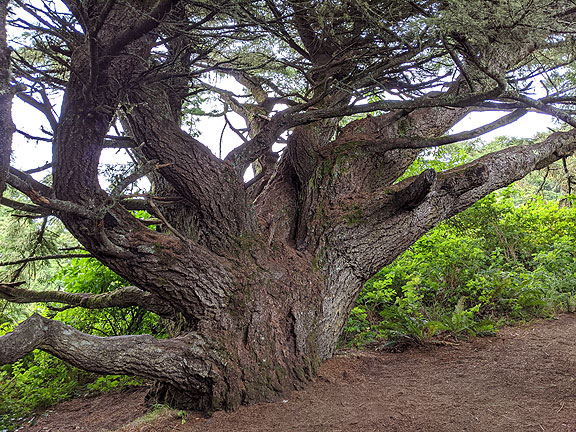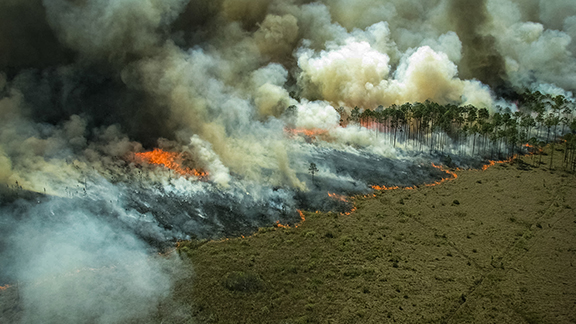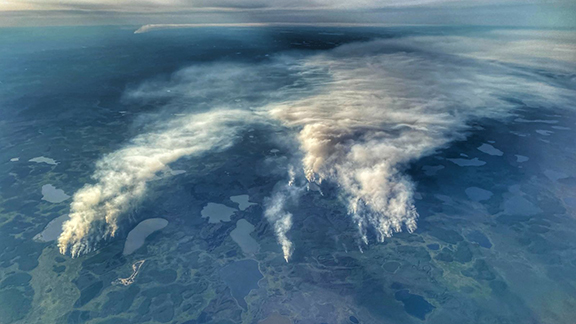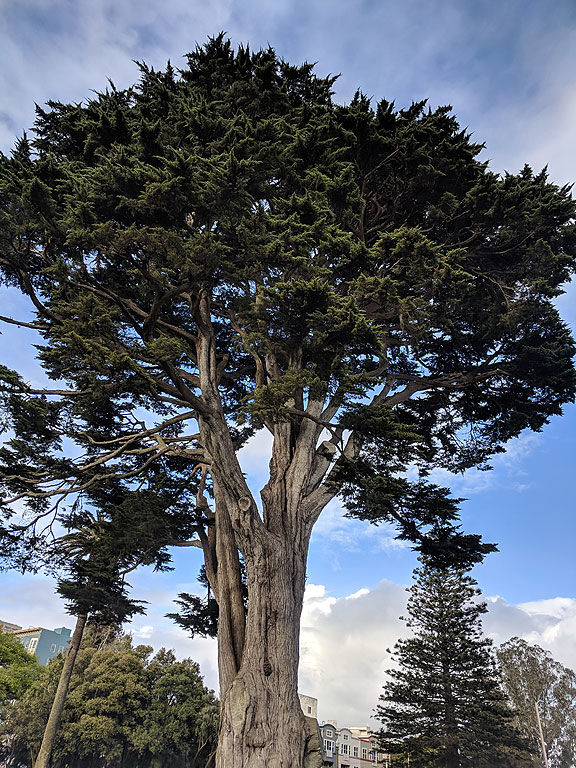The title of this post echoes the post from February about plant sentience for reasons that will become clear. I’ve always loved forests. I say that with the caveat that I’m quite sure nature is trying to kill me. In an ocean, I’m never relaxed, fully expecting a bite or sting from some unseen creature. On land I feel a lot better, and have even been known to bliss out in an old-growth forest. Bugs, bears, and snakes all lurk of course, but I can trust my eyes and ears and feel like I can evade danger if I need to (fond fantasy #23). (Admittedly, I feel safest in cities, where I do the lion’s share of my wandering and exploring, even facing the rare armed hold-up.)
The current surge of catastrophic wildfires, already far worse than any previous year (which we could have said in each of those years), is devastating areas across the northern hemisphere and choking cities thousands of miles away with smoke. In the U.S. this is all compounded by a severe drought over most of the West. But let’s not get too provincial here. In Siberia, wildfires are raging across the once frozen boreal forests, sending tons of carbon into the atmosphere, in a third consecutive year of unheard of drought and fire in the arctic north. And the ongoing destruction of the Amazon in Brazil, Paraguay, Bolivia, Peru, Ecuador, and Colombia adds South America to the hot spots of deforestation-by-fire. Indonesia is another (check that Indonesia link to get to a great website Global Forest Watch, that has a dashboard where you can dive deep into any country in the world and see maps of forest cover, forest loss, fires, and more.)
It’s hard not to feel completely apocalyptic, given the devastation underway, especially in light of the fact that it is part of a very bad feedback cycle, adding ever more carbon ever more rapidly to the atmosphere, which is quickly worsening droughts, floods, and other natural disasters. If we ever doubted that humans are an integral part of nature, it would be impossible now.
But in the midst of this dire situation, I still have confidence that we can turn it around. Some days it seems truly impossible, but when I read a book like Suzanne Simard’s new Finding the Mother Tree, I reconnect to the longer flow of history, as she describes so eloquently her own 45-year path from summer job for a logging company to a new (old) synthesis of modern science and ancient indigenous knowledge.
I have been given a glimpse of these ideals—almost as a stroke of luck—through the rigid lens of western science. I’d been taught in the university to take apart the ecosystem, to reduce it into its parts, to study the trees and plants and soils in isolation, so that I could look at the forest objectively. This dissection, this control and categorization and cauterization, were supposed to bring clarity, credibility, and validation to any findings. When I followed these steps of taking the system apart to look at the pieces, I was able to publish my results, and I soon learned that it was impossible for a study of the diversity and connectivity of a whole ecosystem to get into print. There’s no control!, the reviewers cried at my early papers. Somehow with my Latin scintillation counters, and my training to consider only sharp lines of statistically significant differences, I have come full circle to stumble onto some of the indigenous ideals: Diversity matters. And everything in the universe is connected—between the forests and prairies, the land and the water, the sky and soil, the spirits and the living, the people and all other creatures.
p. 283
Her book is great reading. She hones in, in a rather folksy and anecdotal way, on deep epistemology. How do we know what we know? What is knowing? She intersperses the episodes of her life with her evolving knowledge, from early romance and marriage, kids, moving, career path from lumber companies to British Columbia Forestry Agency to graduate school in Corvallis, Oregon, to eventual tenured professor at University of British Columbia, 9-hour commutes and the impossibility of balancing work and domestic life, divorce, eventually finding new love with a woman, cancer and survival. Amidst it all she makes the stunning discovery that various species of mycorrhizal fungi play key roles in a communicative web among trees in the forest, weaving together “mother” trees with their offspring, as well facilitating the sharing of carbon, water, and other elements with other trees species “in the neighborhood.” With a phalanx of graduate students following her research path, new breakthroughs soon follow, proving what the naked eye can already clearly see: clearcutting old growth forests is like chopping off our limbs. As a child of a horse-logging family of settlers in British Columbia, she is not opposed to a functional connection to trees and forests as resources that we must use. But her research shows that, contrary to lumber industry arguments, birch and douglas fir need each other and support each other over time, and both thrive in each other’s presence, as opposed to the narrow paradigmatic focus on a “competition for resources [water].”
Grown intimately together, this forest had almost twice the productivity of the stands where we’d trenched between the species two decades earlier. This was the opposite of the usual foresters’ expectations. They figured that fir roots free of birch interference would obtain more of the resource pie, as though the ecosystem worked as a zero-sum game—the adamant belief that greater total productivity cannot possibly emerge from species interactions.
p. 281
While her life and research were unfolding, a different kind of plague was rushing across millions of acres of forest. The pine-bark beetle exploded in unprecedented numbers during the late 1990s and early 2000s, and with the steady rise in global temperatures, annual deep freezes that held the beetle’s population in check stopped being as cold. Beetles were able to reproduce further and further north, and their two-year cycle was in many places compressed into one, furthering their population explosion. Published in 2011, Andrew Nikiforuk’s Empire of the Beetle, paints a dire picture of the destruction of pine forests across the West. In fact, Simard notes in various passages the reddening of the pine forests in her British Columbia travels, produced by the pine-bark beetle’s relentless devouring of their favorite target. But she sees the devastation as part of the natural order, where beetle infestations reappear every few decades to kill senescent and ill pines, thinning the forest to make way for a healthy regeneration. By contrast, Nikiforuk’s describes the beetle tidal wave this way:
…the second-greatest insect infestation in the history of North America rolled over a landscape the size of California and brought down a forest that could fill most of Colorado. The epidemic changed entire watersheds and unsettled more than thirty rural and ninety-seven First Nations communities. Economic analysts say the beetle tsunami will influence the price and availability of pine 2x4s on the continent for the next fifty years.
p. 55
This last point about the cost of 2x4s goes to the heart of the discussion, since modern society’s approach to forests is either as resources to be exploited, or as nice scenery for a camping trip. Much of what drives Simard to do her research is her commitment to improving the life of trees and forests, but also to make the argument with clear-cutting loggers that they should preserve old growth trees and allow for diverse species in replanted tree plantations in order to increase the yield they will ultimately be able to get over the long term. Simard does not think forests should be off-limits to logging, but as her knowledge grew she began to reconnect to ancient practices of stewardship that had been in place for thousands of years before rapacious industrial capitalist lumbering practices took over.
Late in her book she raises an interesting question I first heard in a permaculture magazine: that there is a relationship between the protein represented by salmon swimming upstream into mountains to spawn, and then die, and the health of the forests.
I wanted to know whether salmon nitrogen was absorbed by mycorrhizal fungi of the Mother Trees and transmitted through their networks to other trees deeper in the forest. Even more, were the salmon nutrients in the trees declining with the reduction of salmon populations and habitat loss, causing the forests to suffer?
p.289
And I learned in this part of her book about tidal trap technology, which was new to me. Indigenous people along the coast of British Columbia traditionally built stone ponds along the shore whose edges were below high tide. When the high tide surged over and then eventually receded, it left behind salmon in highly sustainable numbers in the stone pools, now accessible at low tide. Brilliant! Of course the British outlawed this form of fishing in the 19th century, but it’s making a comeback. And of course Simard’s research confirmed the presence of salmon nitrogen in the fungi of Mother Trees. In some ways this all seems like common sense and it’s rather astonishing that it has taken into the 21st century to do the science to prove the deep connections that sustain the web of life.
Nikiforuk delves into the long history of the beetle and its relationship to society, once honored and even given legal standing (!), it’s now just an anonymous pest, a vast scourge that deserves whatever chemical or biological warfare humans can unleash on it, as though the beetles were invaders from Mars. But he shows how its presence over centuries was integrated into cultures worldwide.
When human languages and cultures were as diverse as the stars, beetles informed how we lived. They inspired artists, fascinated scientists, illustrated evolution, educated philosophers, pollinated crops, delighted children, hardened warriors, decorated women, and put food on the table. They even merited legal representation in fifteenth-century ecclesiastical courts. Not so long ago, the noble beetle populated our songs, dreams, poems, proverbs, and fables. European peasants gave thanks to “Beasts of the Virgin.” Egyptian pyramid builders wore dung-beetle charms for good luck. Samurai warriors strutted about like Japanese horned beetles, and German and French villagers made soups out of cockchafers. Beetles inspired all sorts of human inventions, including agriculture, the wheel, mummification, the theory of evolution, and yes, the chain saw.
p. 162
As pine-bark beetles proliferate, they are taking down not just the old and weak pines they are known to prefer, but in their overpopulation and voraciousness, they are beginning to attack perfectly healthy stands of pine, as well as other tree species too. The role of these ancient pines in high altitude and high aridity locations in holding together a much vaster web of life is only barely grasped.
…the death of pine in 2,500 drainage basins over an area the size of South Carolina was not good news. Without stands of the ancient pine acting as a fence, the snowpack will grow smaller. And without the protective shading of the pine, the snow will melt earlier and prompt more spring flooding. And without the pines to ration the release of cold water, the mountains will deliver less coolness to the rivers and streams below in late summer. As a consequence, the waters of the Yellowstone and Madison rivers will get too hot to sustain cold-loving native cutthroat trout. Without the hermit pine, the West will rediscover the meaning of aridity, and the change will unhitch things we don’t yet understand. The tree’s impact on water, the report said, will “far outweigh its physical presence on the landscape.”
p. 138
Attention to the ancient relationship of humans to vital trees permeates both of these books. Nikiforuk tells a story rooted in southwestern Indigenous cultures that underscores how attuned humans were to the interactions of the species around them, in fact, their neighbors.
For nearly ten thousand years, the Hopi, Shoshone, Pueblo, Numu, and Navajo well understood the worth of the pinyon tree. The nut gatherers basically managed Pinus edulis and Pinus monophylla forests as nut orchards. They thinned and fired the forest to ensure mixed-age stands of high-producing nut pines and for good reason. Rich in protein, fat, iron and vitamin D, the pinyon nut is a civilization builder and a culture maker. Ronald Lanner, the U.S. naturalist and former forest researcher, notes that the Colorado pinyon nut provides more calories than a “pound of chocolate and nearly as much as in a pound of butter.” The nut also contains more essential amino acids than cornmeal does.
p. 147
The trees made their own sad music. A parched pinyon typically produces a variety of powerful pops that sound like distant drumbeats. Botanists call this collapse of cells “cavitation” and use it as a measure for drought stress… These cavitation events release both light and sound signals that fall between an audible range (twenty kilohertz) and an ultrasonic range (two thousand kilohertz). The human ear can hear frequencies up to twenty kilohertz of sound. Dunn and a growing number of scientists suspect that bark beetles may home in on these cavitation signals. As the Pueblo put it, the beetles hear a tree crying in an arid land.
p.154
Clearly we have to redouble efforts to stop rapacious logging and burning of old-growth forests. Both of these books help uncover deeper relationships, usually ones that persisted for millennia, between forests and humans and other species. As our knowledge and understanding have slowly been reconnecting to ancient truths, the destruction has accelerated. We are in a race against time and the inexorable forces of capital as they continue their eco-cidal assault on life. But maybe we are not in this merely as isolated well-meaning individuals. Perhaps the web of life is asserting itself and can also eventually repair itself, given space and even a bit of help from those who have figured (some of it) out.
Last word to Suzanne Simard:
Our modern societies have made the assumption that trees don’t have the same capacities as humans. They don’t have nurturing instincts. They don’t cure one another don’t administer care. But now we know Mother Trees can truly nurture their offspring. Douglas firs, it turns out, recognize their kin and distinguish them from other families and different species. They communicate and send carbon, the building block of life, not just to mycorrhizas of their kin but to other members of the community. To help keep it whole. They appear to relate to their offspring as do mothers passing their best recipes to their daughters. Conveying their life energy, their wisdom, to carry life forward.
p. 277
Of late I’ve become increasingly enchanted by the story told by Subiyay, who talks of trees as people. Not only with a sort of intelligence—akin to us humans—or even a spiritual quality perhaps not unlike ours. Not merely as equivalent to people, with the same bearings. They are people. The Tree People.
p. 294
Check out The Mother Tree Project!

















Wow, Chris, this blew my mind. I definitely want to read those two books, and can think of a few people who I would like to gift those books to. THUMBS UP!